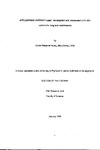Ichthyophthirius multifiliis Fouquet: development and assessment of in vitro systems for long term maintenance
| dc.contributor.author | Hurley, Louise Margaret | |
| dc.contributor.other | School of Biological and Marine Sciences | en_US |
| dc.date.accessioned | 2013-11-01T10:54:13Z | |
| dc.date.available | 2013-11-01T10:54:13Z | |
| dc.date.issued | 1999 | |
| dc.identifier | NOT AVAILABLE | en_US |
| dc.identifier.uri | http://hdl.handle.net/10026.1/2526 | |
| dc.description | Merged with duplicate record 10026.1/785 on 15.02.2017 by CS (TIS) | |
| dc.description.abstract |
Twelve isolates of lchthyophthirius multifiliis were successfully established and maintained by serial passage through naive carp, for a maximum of 39 laboratory cycles. The management system employed was such that large numbers of the parasite were available for all investigations. The ability to induce exit of immature trophonts through media incubation was used to confirm events in the initial stages of host colonisation. The normal course of primary infection was also established providing useful criteria for assessing success of the in vitro systems tested. Survival of both theronts and tomonts within selected monophasic media was investigated. Theronts in Eagles Minimum Essential medium (EMEM). survived and were viable for 120 hours. 72 hours longer than water controls. No further development of the theronts was observed. Tomonts also demonstrated an increased survival time in comparison to the controls with tomites surviving within the cyst for 22 days within EMEM-S media diluted 50:50 with sterile distilled water. Division of tomonts was identified as being precystic, post divisional cystic or cystic, and the frequency of such divisions was dependent upon dilution of media, Sterile viable theronts were recovered at 168h from tomonts that had been incubated within EMEM diluted 30:70 with distilled water. Delayed encystment was achieved by incubation in concentrated media, theront production being delayed for 96h, 72h later than seen in the aquatic environment. Cultured cell monolayers were used as associates within culture systems. Behaviour of theronts on introduction into the culture systems indicated recognition of the cultured tissue as potential host material, sustained contact of up to 120hours was observed between the introduced parasite and cells. However, no developmental markers were identified within the cultured parasite and no significant growth was achieved. Attempts to simulate the situation in vivo by use of multilayered systems and crude cell explants were also unsuccessful. Transmission electron microscopy of the parasite within a cell aggregate system was undertaken at daily intervals up to 120h providing evidence that the parasite was attempting to gain nutrients by phagocytosis. However, increased vacuolation of the parasite during the period of culture was clearly evident leading eventually to parasite death. The significance of the results is discussed in relation to the normal course of infection and the future promise of a long term culture method for this important pathogen. | en_US |
| dc.language.iso | en | en_US |
| dc.publisher | University of Plymouth | en_US |
| dc.title | Ichthyophthirius multifiliis Fouquet: development and assessment of in vitro systems for long term maintenance | en_US |
| dc.type | Thesis | |
| plymouth.version | Full version: final and full version as approved by the examiners at the time of the award of your degree | en_US |
| dc.identifier.doi | http://dx.doi.org/10.24382/4165 | |
| dc.identifier.doi | http://dx.doi.org/10.24382/4165 |
Files in this item
This item appears in the following Collection(s)
-
01 Research Theses Main Collection
Research Theses Main


